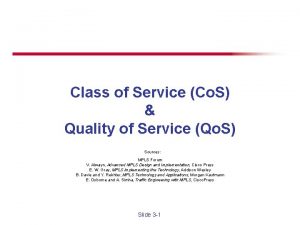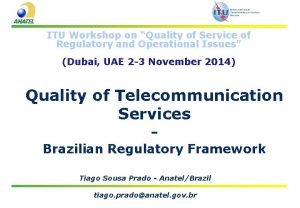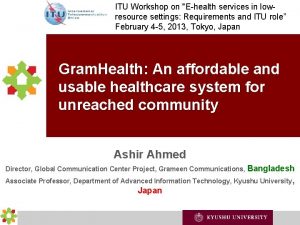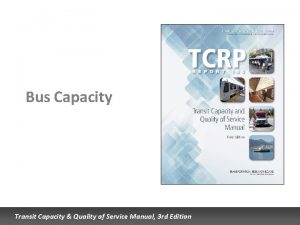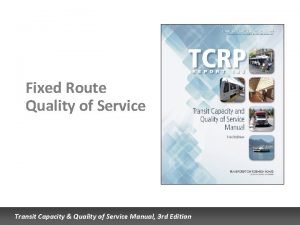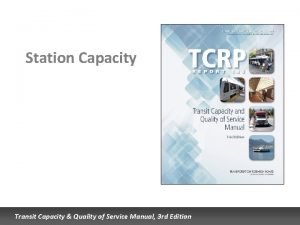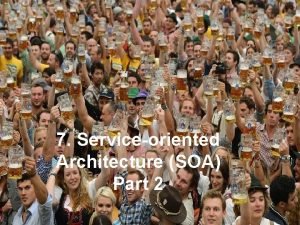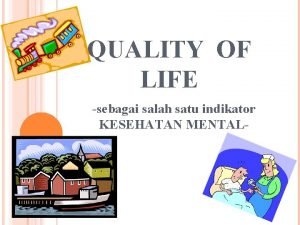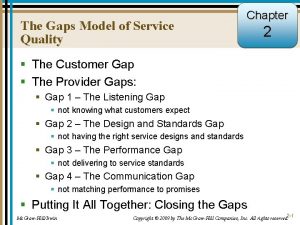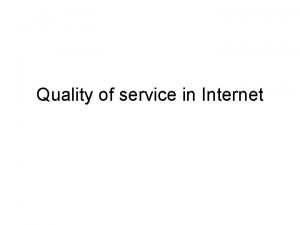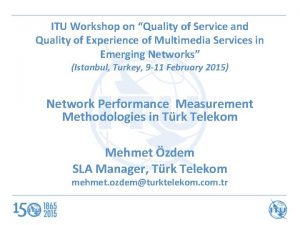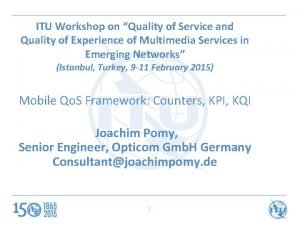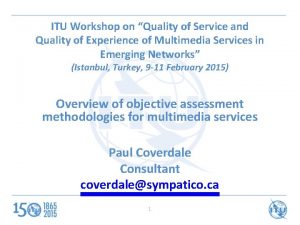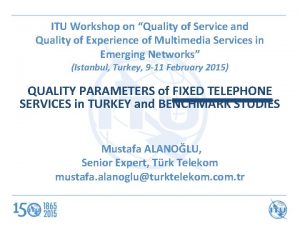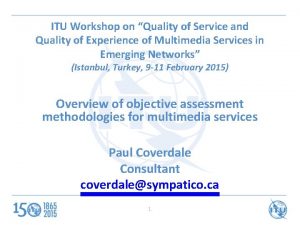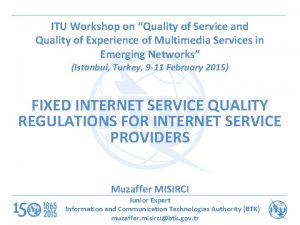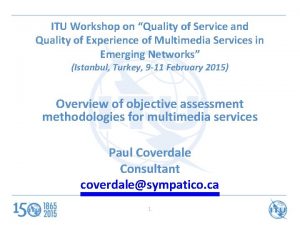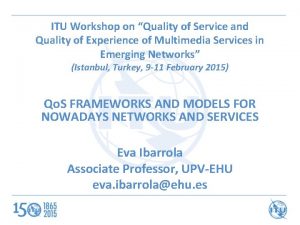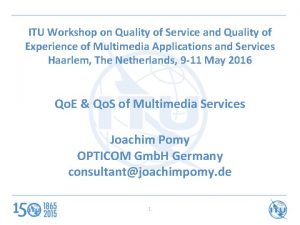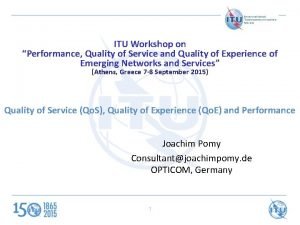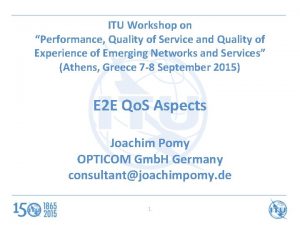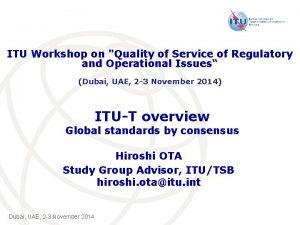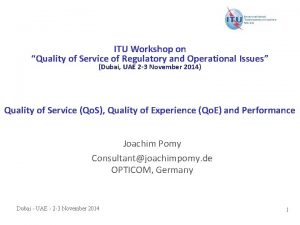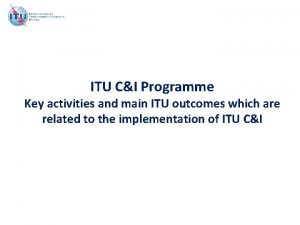ITU Workshop on Quality of Service and Quality

























- Slides: 25

ITU Workshop on “Quality of Service and Quality of Experience of Multimedia Services in Emerging Networks” (Istanbul, Turkey, 9 -11 February 2015) Standardization activities on optical access transport systems in ITU-T SG 15 Hiroshi OTA Advisor, ITU/TSB hiroshi. ota@itu. int

Overview 2

ITU-T Study Groups (SGs) • • • SG 2: Operational aspects of service provision and telecommunications management SG 3: Tariff and accounting principles including related telecommunication economic and policy issues SG 5: Environment and climate change SG 9: Television and sound transmission and integrated broadband cable networks SG 11: Signalling requirements, protocols and test specifications SG 12: Performance, Qo. S and Qo. E SG 13: Future networks including cloud computing, mobile and next-generation networks SG 15: Networks, technologies and infrastructures for transport, access and home SG 16: Multimedia coding, systems and applications SG 17: Security TSAG: Telecommunication Standardization Advisory Group 3

SG 15: Networks, Technologies and Infrastructures for Transport, Access and Home • Optical transport networks and access network infrastructures • Optical and other infrastructures, systems, equipment, fibres, control plane technologies • Customer premises, access, metropolitan and long haul • Lead SG for: – – access network transport optical technology optical transport networks smart grid Details are at http: //www. itu. int/en/ITU-T/studygroups/2013 -2016/15 4

Questions under SG 15 • • • • • Q 1: Coordination of access and Home Network Transport standards Q 2: Optical systems for fibre access networks Q 3: General characteristics of transport networks Q 4: Broadband access over metallic conductors Q 5: Characteristics and test methods of optical fibres and cables Q 6: Characteristics of optical systems for terrestrial transport networks Q 7: Characteristics of optical components and subsystems Q 8: Characteristics of optical fibre submarine cable systems Q 9: Transport network protection/restoration Q 10: Interfaces, Interworking, OAM and Equipment specifications for Packet based Transport Networks Q 11: Signal structures, interfaces, equipment functions, and interworking for transport networks Q 12: Transport network architectures Q 13: Network synchronization and time distribution performance Q 14: Management and control of transport systems and equipment Q 15: Communications for Smart Grid Q 16: Outside plant and related indoor installation Q 17: Maintenance and operation of optical fibre cable networks Q 18: Broadband in-premises networking 5

From recent development • G. fast (Fast Access to Subscriber Terminals) (Q 4/15 and Q 16/15) – FTTdp (Fibre to the distribution point) – G. fast transceiver aspects are under development by Q 4/15 – G. fast infrastructural aspects of FTTdp deployment is under study by Q 16/15 • PON (Passive optical networks) (Q 2/15) and optical fibres for FTTH (Q 5/15) – Major technology for FTTH (Fiber to the home) 6

G. Fast - Fast Access to Subscriber Terminals (Q 4/15) 7

What is FTTdp ? • A broadband access solution taking fibre to a distribution point (FTTdp) very close to the customers premises, with total wire length to the customers’ transceiver up to 250 m. – It is expected that the bulk of the loop lengths may be in the order 30 to 50 m. On 30 m loops, aggregate data rates up to at least 500 Mb/s should be supported on a single pair. 8

FTTdp/G. fast “raison d’être” • To provide the best aspects of ‘Fibre to the home’ and ‘ADSL’: – Fibre to the home bit-rates – customer self-installation like ADSL 9

Applications • Next-generation IPTV service at well over 100 Mb/s • Access to small and medium business sites at well over 100 Mb/s • Backhaul for very small wireless cell sites, including Het. Net • Backhaul for Wi. Fi hot spots 10

Service rate performance targets • • • 500 -1000 Mb/s for FTTB deployments @<100 m, straight loops 500 Mb/s at 100 m 200 Mb/s at 200 m 150 Mb/s at 250 m Aggregate service rates ≥ 500 Mb/s with start frequency of 23 MHz and VHF and DAB bands notches 11

Migration example • Coexistence with x. DSL: VDSL 2 to G. fast migration 12

Standards time-line • September 2010: Broadband Forum (BBF) Service Provider Action Council (SPAC) agreed to develop a white paper capturing network operators’ potential requirements. • January 2011: At request of BBF, ITU-T Q 4/15 agreed to study the transceiver aspects of FTTdp, and issued a call for papers. • February 2011: Q 4/15 opened G. fast project and assigned an Associate Rapporteur/Editor • June 2011: Q 4/15 agreed to develop a new Recommendation • Recommendation ITU-T G. 9700 (Power spectral density specification) – approved in March, 2014 • Recommendation ITU-T G. 9701 (Physical layer specification) – approved in December 2014 13

Standards body cooperation • Close cooperation between standards groups is needed: – ITU-T Q 4/15 for G. fast transceiver aspects – ITU-T Q 2/15 for PON related aspects – Broadband Forum (FAN and E 2 E Architecture WGs) for architectural aspects – Broadband Forum addresses certification and interoperability testing of equipment based on ITU-T GPON and DSL Recommendations, and – ETSI TM 6 for reverse power feeding aspects 14

PON (Passive Optical Networks) (Q 2/15) and optical fibres for FTTH (Q 5/15) 15

PON Evolution • G-PON (Gigabit-capable PON) • NG-PON 1 = XG-PON (10 Gbit-capable. PON) • NG-PON 2 = TWDM-PON (40 Gbit-capable PON) 16

Capacity Trend for PON 250 G Bandwidth 100 G 40 G 10 G Downstream Upstream 40 G 10 G 2. 5 G 0. 6 G 0. 15 G 0. 05 G Generation 1994 TPON 1999 A-PON B-PON 2004 G-PON GEPON 2009 NG-PON 1 XG-PON 10 GEPON 2014 NG-PON 2 TWDM-PON 2020+ NG-PON 3 ? 17

G-PON: Widely deployed • G-PON: Gigabit-capable passive optical networks • System defined in the Recommendation ITU-T G. 984 series – – Recommendation ITU-T G. 984. 1: System requirements Recommendation ITU-T G. 984. 2: PMD specifications Recommendation ITU-T G. 984. 3: TC specifications Recommendation ITU-T G. 984. 4: OMCI - Subsumed by Recommendation ITU-T G. 988 • Now used for all ITU PONs and P 2 P systems – – Recommendation ITU-T G. 984. 5: WDM matters for the future Recommendation ITU-T G. 984. 6: Reach extension Recommendation ITU-T G. 984. 7: Long reach Plus supplements… • Standards considered stable and mature • Minor optional enhancements continue even now 18

XG-PON • XG-PON: 10 -Gigabit-capable passive optical networks • System defined in the Recommendation ITU-T G. 987 series – Recommendation ITU-T G. 987: Definitions, abbreviations and acronyms – Recommendation ITU-T G. 987. 1: General requirements – Recommendation ITU-T G. 987. 2: Physical media dependent (PMD) layer specification – Recommendation ITU-T G. 987. 3: Transmission convergence (TC) layer specification – Recommendation ITU-T G. 987. 4: Reach extension 19

XG-PON system (ITU-T G. 987 series) coexisting with G-PON GPON OLT NNI Data I/O GPON OLT MAC Logic GPON ONU OLT Tx 1490 nm OLT Rx 1310 nm WDM 1 ONU Tx 1310 nm WDM GPON ONU MAC Logic UNI Data I/O XG-PON ONU 1310 nm OLT Tx 1577 nm OLT Rx 1270 nm WDM 1577 nm XG-PON OLT XGPON NNI OLT Data MAC I/O Logic 1490 nm WDM ONU Rx 1490 nm 1270 nm ONU Rx 1577 nm WDM ONU Tx 1270 nm 20

NG-PON 2 • NG-PON 2: 40 -Gigabit-capable passive optical networks • System defined in the Recommendation ITU-T G. 989 series – Recommendation ITU-T G. 989 : Definitions and conventions – Recommendation ITU-T G. 989. 1: General requirements – Recommendation ITU-T G. 989. 2: Physical media dependent (PMD) layer specification – Recommendation ITU-T G. 989. 3: Transmission convergence (TC) layer specification (draft in progress) • Based on G. 987. 3, with wavelength control and 10 G upstream added – Recommendation ITU-T G. 9802 (ex. G. multi) = Wavelength control layer (consented in December 2014) • Meant as a general framework for TWDM-systems, of which G. 989 is one – Recommendation ITU-T G. 984. 5 = Wavelength coexistence – Recommendation ITU-T G. 988 = ONU management and control interface • Standard in force, can be easily reused for TWDM 21

NG-PON 2 Wavelength Plans (ITU-T G. 989. 2) Wavelength Compatible Systems GPON, RF Video, XGPON 1 Downstream 1596 -1603 nm TWDM Upstream Pt. P WDM PON Upstream/Downstream Wide Range Shared Spectrum 1524 -1544 nm 1603 -1625 nm Reduced Range Expanded Spectrum 1528 -1540 nm 1524 -1625 nm Narrow Range 1532 -1540 nm 22

Evolution in the recommendation for Recommendation ITU-T G. 652 fibers Existing Recommendation ITU-T G. 652. D category is already optimized to be used with G-PON and XG-PON systems, with the necessity to define attenuation attribute in the range of interest (1260 nm - 1650 nm) A new category has been proposed with enhanced behavior in attenuation and bending loss for both transport and access networks applications Proposals under evaluation: to reduce the existing MFD range in order to improve the compatibility with other single mode categories (e. g. Recommendation ITU-T G. 657) to improve the geometrical requirements in order to enable the use of low cost connectors or splicing machines in access network necessity to define attenuation attribute in the range of interest in access network: 1260 nm e 1650 nm 23

Evolution in the recommendation for Recommendation ITU-T G. 657 fibers • Optimization of B 2/B 3 categories (not necessary compliant with Recommendation ITU-T G. 652) has been developed: – improved compatibility with other Recommendation ITU-T G. 657 categories and with Recommendation ITU-T G. 652 with the reduction of MFD range (Minimum typical MFD was modified from 6. 3 mm to 8. 6 mm) • Definition of methods to measure MPI in Recommendation ITU-T G. 650. 1 • Proposals under evaluation: Proposal to reduce existing MFD range also for A 1/A 2 subcategories in order to improve the compatibility with other single mode categories (e. g. Recommendation ITU-T G. 652) and to harmonize with Cenelec standards on connectors. That would result in an improvement in OTDR unidirectional measurements interpretation (this measurement could be necessary to be used on PON networks where bidirectional test is not usable to localize faults). Necessity to go deep in the study of mechanical reliability related to the FTTH installation conditions 24

Thank you xx. xxx@itu. int hiroshi. ota@itu. int
 Class of service vs quality of service
Class of service vs quality of service Apa itu workshop
Apa itu workshop Apa itu workshop
Apa itu workshop Quality attribute workshop
Quality attribute workshop Quality control and quality assurance
Quality control and quality assurance Basic quality concepts
Basic quality concepts Improving service quality and productivity ppt
Improving service quality and productivity ppt Service quality and productivity
Service quality and productivity Transit capacity and quality of service manual
Transit capacity and quality of service manual Transit capacity and quality of service manual
Transit capacity and quality of service manual Transit capacity and quality of service manual
Transit capacity and quality of service manual Factors that influence desired service expectations
Factors that influence desired service expectations Evolution of soa
Evolution of soa Indikator quality of life
Indikator quality of life Plan quality management pmp
Plan quality management pmp What are quality standards in project management
What are quality standards in project management Quality assurance cycle in nursing
Quality assurance cycle in nursing Quality improvement vs quality assurance
Quality improvement vs quality assurance Quality definition by quality gurus
Quality definition by quality gurus Quality is free
Quality is free Old quality vs new quality
Old quality vs new quality Quality weld service
Quality weld service Provider gap 3
Provider gap 3 Provider gap 4
Provider gap 4 Irates complainers
Irates complainers Internet quality of service
Internet quality of service
